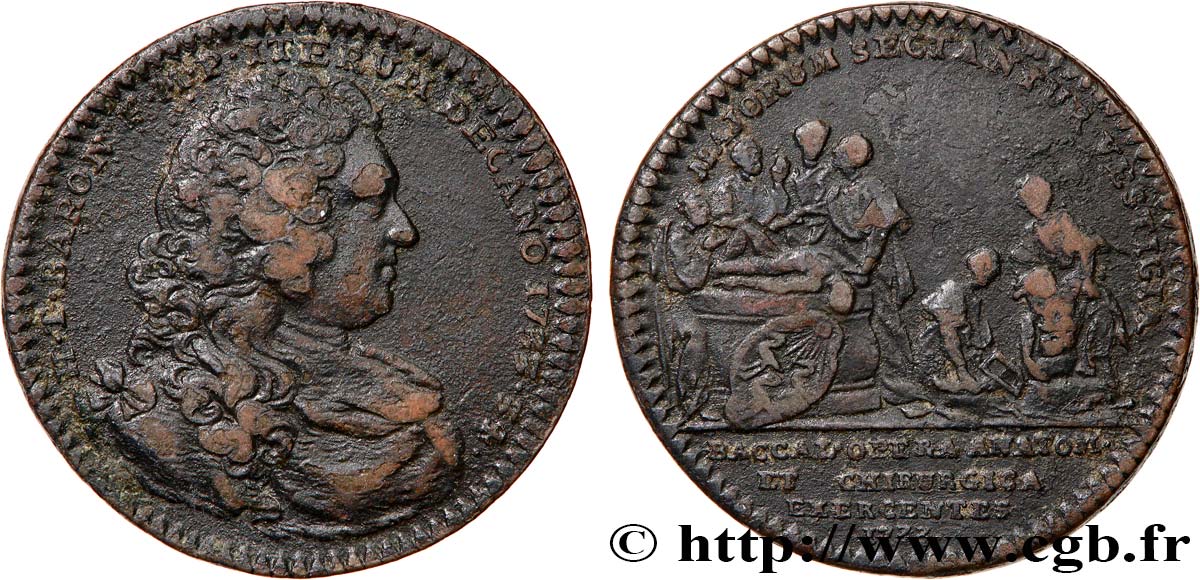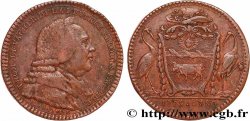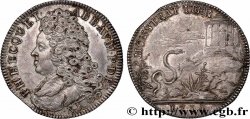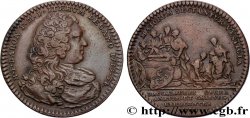fjt_755457 - DOYENS DE LA FACULTÉ DE MÉDECINE DE PARIS Hyacinthe-Théodore Baron, doyen 1734
40.00 €
Cantidad
Añadir a su cesta

Tipo : Hyacinthe-Théodore Baron, doyen
Fecha: 1734
Nombre del taller / ciudad: s.l.
Metal: cobre rojo
Diámetro: 29 mm
Eje de acuñación: 6 h.
Peso: 7,89 g.
Canto: lisse
Comentarios sobre el estado de conservación:
Patine très sombre. Présence de traces d’usure et de faiblesses de frappe à l’avers et au revers. Des concrétions vertes sont également visibles à l’avers
Pedigrí:
Exemplaire provenant de la Collection MARINECHE
Anverso
Titulatura del anverso: H. T. BARON. F. M. P. ITERUM. DECANO.
Descripción del anverso: Buste à droite de H.T. Baron.
Reverso
Titulatura del reverso: MAJORUM SECTANTUR VESTIGIA ; À L'EXERGUE : BACCAL/ OPERA. NATOM. ET. CHIRURGICA. EXERCENTES. 1733.
Descripción del reverso: Six personnages procédant à des dissections. Au pied de la table, les armes de la Faculté.
Traducción del reverso: Ils dissèquent les cadavres de leurs ancêtres ; à l'exergue : Les étudiants s'exerçant à des travaux d'anatomie et de chirurgie - 1733.
Comentario
Ce jeton commémore l'introduction dans les épreuves du baccalauréat des épreuves d'anatomie.
Hyacinthe-Théodore Baron est médecin en 1710, il sera aussi professeur de chirurgie et de pharmacie. Très zélé, il fut doyen à deux reprises : un décanat en 1730-1734 puis de 1750 à 1754.
La faculté de médecine de Paris est l'une des quatre composantes de l'Université de Paris avec la faculté de théologie, la faculté de droit et la faculté des arts ou lettres. En 1789, elle se composait de cent cinquante-deux docteurs dont sept étaient attitrés pour enseigner la matière médicale, la physiologie, la pathologie, la pharmacie, les accouchements, la chirurgie française et la chirurgie latine. La faculté de médecine était dirigée par un doyen qui était aussi chargé de former le tribunal de l'Université avec les doyens de théologie et de droit et les quatre procureurs de la faculté des arts. Le doctorat en médecine était obtenu après six années d'étude et l'obtention des grades de bachelier, licencié et enfin docteur.
This token commemorates the introduction of anatomy exams into the baccalaureate exams. Hyacinthe-Théodore Baron was a doctor in 1710, and he was also a professor of surgery and pharmacy. Very zealous, he was dean twice: a deanship in 1730-1734 and then from 1750 to 1754. The Faculty of Medicine of Paris is one of the four components of the University of Paris, along with the Faculty of Theology, the Faculty of Law, and the Faculty of Arts or Letters. In 1789, it consisted of one hundred and fifty-two doctors, seven of whom were appointed to teach materia medica, physiology, pathology, pharmacy, childbirth, French surgery, and Latin surgery. The Faculty of Medicine was headed by a dean who was also responsible for forming the University tribunal with the deans of theology and law and the four prosecutors of the Faculty of Arts. The doctorate in medicine was obtained after six years of study and the attainment of the degrees of bachelor, licentiate and finally doctor.
Hyacinthe-Théodore Baron est médecin en 1710, il sera aussi professeur de chirurgie et de pharmacie. Très zélé, il fut doyen à deux reprises : un décanat en 1730-1734 puis de 1750 à 1754.
La faculté de médecine de Paris est l'une des quatre composantes de l'Université de Paris avec la faculté de théologie, la faculté de droit et la faculté des arts ou lettres. En 1789, elle se composait de cent cinquante-deux docteurs dont sept étaient attitrés pour enseigner la matière médicale, la physiologie, la pathologie, la pharmacie, les accouchements, la chirurgie française et la chirurgie latine. La faculté de médecine était dirigée par un doyen qui était aussi chargé de former le tribunal de l'Université avec les doyens de théologie et de droit et les quatre procureurs de la faculté des arts. Le doctorat en médecine était obtenu après six années d'étude et l'obtention des grades de bachelier, licencié et enfin docteur.
This token commemorates the introduction of anatomy exams into the baccalaureate exams. Hyacinthe-Théodore Baron was a doctor in 1710, and he was also a professor of surgery and pharmacy. Very zealous, he was dean twice: a deanship in 1730-1734 and then from 1750 to 1754. The Faculty of Medicine of Paris is one of the four components of the University of Paris, along with the Faculty of Theology, the Faculty of Law, and the Faculty of Arts or Letters. In 1789, it consisted of one hundred and fifty-two doctors, seven of whom were appointed to teach materia medica, physiology, pathology, pharmacy, childbirth, French surgery, and Latin surgery. The Faculty of Medicine was headed by a dean who was also responsible for forming the University tribunal with the deans of theology and law and the four prosecutors of the Faculty of Arts. The doctorate in medicine was obtained after six years of study and the attainment of the degrees of bachelor, licentiate and finally doctor.








 Informar de un error
Informar de un error Imprimir la página
Imprimir la página Comparte mi selección
Comparte mi selección Haz una pregunta
Haz una pregunta Consignar / vender
Consignar / vender
 Descriptivo
Descriptivo










